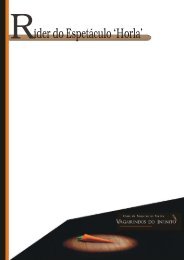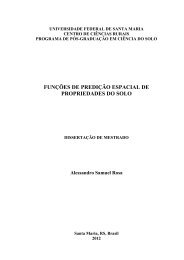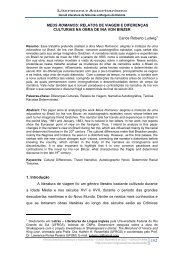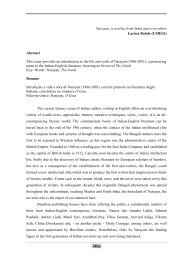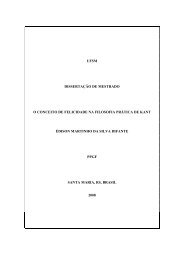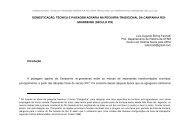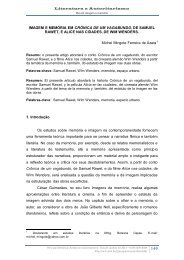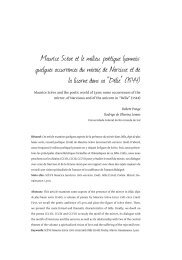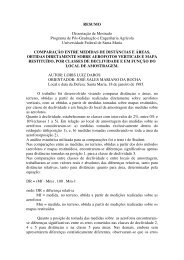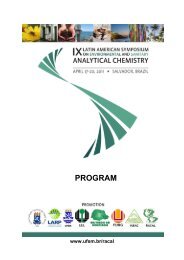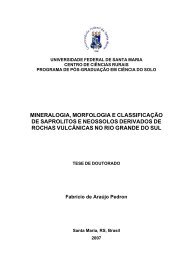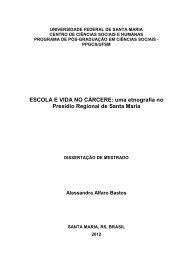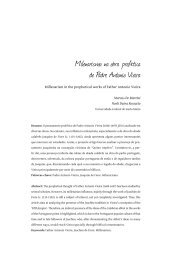- Page 1 and 2: UNIVERSIDADE FEDERAL DE SANTA MARIA
- Page 4 and 5: A você, Vitória, minha filha amad
- Page 6 and 7: Aos meus colegas de curso, nas dife
- Page 8 and 9: 1.6 Referências Bibliográficas...
- Page 10 and 11: RESUMO Tese de Doutorado Programa d
- Page 14 and 15: LISTA DE TABELAS página Tabela 1 H
- Page 16 and 17: Tabela 19 Estoque de carbono orgân
- Page 18 and 19: LISTA DE FIGURAS página Figura 1 V
- Page 20 and 21: Figura 20 Distribuição relativa d
- Page 22 and 23: Figura 38 Distribuição relativa d
- Page 24 and 25: LISTA DE ANEXOS página Anexo A Per
- Page 26 and 27: De 1990 a 2006, a área brasileira
- Page 28 and 29: em superfície e pela baixa taxa de
- Page 30 and 31: MATERIAL E MÉTODOS GERAL Localiza
- Page 32 and 33: Tabela 1. Histórico dos sistemas d
- Page 34 and 35: As dimensões de cada parcela foram
- Page 36 and 37: com herbicidas após a colheita de
- Page 38 and 39: IBGE - INSTITUTO BRASILEIRO DE GEOG
- Page 40 and 41: 1 CAPÍTULO I ALTERAÇÕES EM ATRIB
- Page 42 and 43: Propriedades físicas do solo, em m
- Page 44 and 45: Espécies de adubos verdes de verã
- Page 46 and 47: 1.3.2 Resistência do solo ao penet
- Page 48 and 49: pousio invernal, azevém + ervilhac
- Page 50 and 51: Tabela 3. Densidade do solo (Ds), p
- Page 52 and 53: O uso e o tráfego intensivo de má
- Page 54 and 55: e ao elevado teor de areia do solo,
- Page 56 and 57: Observa-se que em nenhum momento o
- Page 58 and 59: compactação avançado, restritivo
- Page 60 and 61: Os valores do Coeficiente de Varia
- Page 62 and 63:
na superfície do solo, considerand
- Page 64 and 65:
o nabo forrageiro (Sasal & Andriulo
- Page 66 and 67:
Macroporosidade do solo, dm 3 dm -3
- Page 68 and 69:
1.6 REFERÊNCIAS BIBLIOGRÁFICAS AB
- Page 70 and 71:
DERPSCH, R. et al. Manejo do solo c
- Page 72 and 73:
NICOLOSO, R.S; AMADO, T.J.C.; LOVAT
- Page 74 and 75:
WARRICK A.W. & NIELSEN, D.R. Spatia
- Page 76 and 77:
2.2 INTRODUÇÃO A manutenção dos
- Page 78 and 79:
é viável e adquire fundamental im
- Page 80 and 81:
2.3 MATERIAL E MÉTODOS O experimen
- Page 82 and 83:
elacionados à acidez do solo em pr
- Page 84 and 85:
valores de Ca+Mg trocáveis, não d
- Page 86 and 87:
Num experimento de longa duração,
- Page 88 and 89:
da produção matéria seca e da re
- Page 90 and 91:
Além disso, a prática do pousio i
- Page 92 and 93:
maior acúmulo desse nutriente nos
- Page 94 and 95:
da aveia preta e do nabo forrageiro
- Page 96 and 97:
que é atribuído diretamente a rem
- Page 98 and 99:
suficientes para elevar significati
- Page 100 and 101:
Capacidade de troca de cátions, cm
- Page 102 and 103:
101 Pela análise das Figuras 12 e
- Page 104 and 105:
BORKERT, C.M.; GAUDÊNCIO, J.E.; PE
- Page 106 and 107:
JANTALIA, C.P.; SANTOS, H.P.; DENAR
- Page 108 and 109:
SANTOS, H.P.; FONTANELI, R.S.; TOMM
- Page 110 and 111:
O sistema plantio direto com utiliz
- Page 112 and 113:
desses nutrientes aportados, aument
- Page 114 and 115:
tratamento. Para fazer a coleta uti
- Page 116 and 117:
115 A análise isolada de cada safr
- Page 118 and 119:
esíduos e imediata liberação de
- Page 120 and 121:
119 Bergamaschi et al. (2004) const
- Page 122 and 123:
A fertilidade do solo é outro fato
- Page 124 and 125:
123 Observa-se que para as duas cul
- Page 126 and 127:
125 A cultura do nabo forrageiro ap
- Page 128 and 129:
existindo também certa igualdade e
- Page 130 and 131:
soja/trigo não foi capaz de increm
- Page 132 and 133:
131 Lovato (2001), num experimento
- Page 134 and 135:
MUC e AZEV apresentaram valores sup
- Page 136 and 137:
Na camada total (0,0 - 0,20 m), o t
- Page 138 and 139:
profundidade no perfil, sendo inclu
- Page 140 and 141:
3.6 REFERÊNCIAS BIBLIOGRÁFICAS AM
- Page 142 and 143:
CRUZ, A.C.R.; PAULETTO, E.A.; FLORE
- Page 144 and 145:
NICOLOSO, R.S; AMADO, T.J.C.; LOVAT
- Page 146 and 147:
4 CAPÍTULO IV PERDAS DE SOLO E ÁG
- Page 148 and 149:
(Debarba, 1993; Seganfredo et al.,
- Page 150 and 151:
149 O efeito de plantas de cobertur
- Page 152 and 153:
Wischmeier & Smith (1978) e modific
- Page 154 and 155:
153 O pousio invernal concentrou su
- Page 156 and 157:
155 Os meses de outubro, janeiro e
- Page 158 and 159:
157 Beutler et al. (2003) encontrar
- Page 160 and 161:
durante o ano, podem apresentar ele
- Page 162 and 163:
As perdas mensais de solo constatad
- Page 164 and 165:
163 No início do período a cobert
- Page 166 and 167:
2, durante a execução do experime
- Page 168 and 169:
167 A erosividade da chuva pode ser
- Page 170 and 171:
Distribuição relativa, % 100 90 8
- Page 172 and 173:
no inverno (POU), que foi o tratame
- Page 174 and 175:
173 Com exceção do solo continuam
- Page 176 and 177:
175 A Figura 33 apresenta as perdas
- Page 178 and 179:
início de primavera, e ao longo do
- Page 180 and 181:
179 Na Figura 34 observa-se a difer
- Page 182 and 183:
181 A condição que manteve o solo
- Page 184 and 185:
183 Os anos que registraram as maio
- Page 186 and 187:
185 Os demais tratamentos apresenta
- Page 188 and 189:
187 Os tratamentos POU e CNA aprese
- Page 190 and 191:
Distribuição relativa, % 18 16 14
- Page 192 and 193:
no sistema de plantio direto normal
- Page 194 and 195:
aos demais tratamentos sob plantio
- Page 196 and 197:
Perdas de água, mm 700 600 500 400
- Page 198 and 199:
em conseqüência, nos valores de e
- Page 200 and 201:
Perdas de água, mm 10000 9500 9000
- Page 202 and 203:
Tabela 25. Perdas totais de água a
- Page 204 and 205:
proporcionada pela parte aérea das
- Page 206 and 207:
várias vezes, como por exemplo, as
- Page 208 and 209:
elação direto entre volume precip
- Page 210 and 211:
Índice EI 30 , MJ mm ha -1 h -1 12
- Page 212 and 213:
211 As Figuras 51 e 52 apresentam,
- Page 214 and 215:
capacidade máxima de infiltração
- Page 216 and 217:
proposta foi determinada em outros
- Page 218 and 219:
os de menor resistência. Porém, d
- Page 220 and 221:
Tabela 30. Razão de perdas de solo
- Page 222 and 223:
das plantas) (Prochnow et al., 2005
- Page 224 and 225:
4.5 CONCLUSÕES 1. A manutenção d
- Page 226 and 227:
BERTOL, I.; BARBOSA, F.T.; FABIAN,
- Page 228 and 229:
PESQUISA SOBRE CONSERVAÇÃO DO SOL
- Page 230 and 231:
FRYE, W.W.; EBELHAR, S.A.; MURDOCK,
- Page 232 and 233:
SEGANFREDO, M.L.; ELTZ, F.L.F. & BR
- Page 234 and 235:
CONSIDERAÇÕES FINAIS E SUGESTÕES
- Page 236 and 237:
ANEXOS
- Page 238 and 239:
Continuação anexo A 1994 Tratamen
- Page 240 and 241:
Continuação anexo A 1997 Tratamen
- Page 242 and 243:
Continuação anexo A 2000 Tratamen
- Page 244 and 245:
Continuação anexo A 2003 Tratamen
- Page 246 and 247:
Continuação anexo A 2006 Tratamen
- Page 248 and 249:
Anexo B. Perdas de água, em mm, no
- Page 250 and 251:
Continuação anexo B 1996-1997 Tra
- Page 252 and 253:
Continuação anexo B 1999-2000 Tra
- Page 254 and 255:
Continuação anexo B 2002-2003 Tra
- Page 256 and 257:
Continuação anexo B 2005-2006 Tra
- Page 258 and 259:
Rendimento de grãos de soja, sacas
- Page 260 and 261:
a) b) Anexo E. Detalhe da determina
- Page 262 and 263:
a) b) Anexo G. Detalhe da parcela e
- Page 264:
a) b) Anexo I. Detalhe das calhas c




